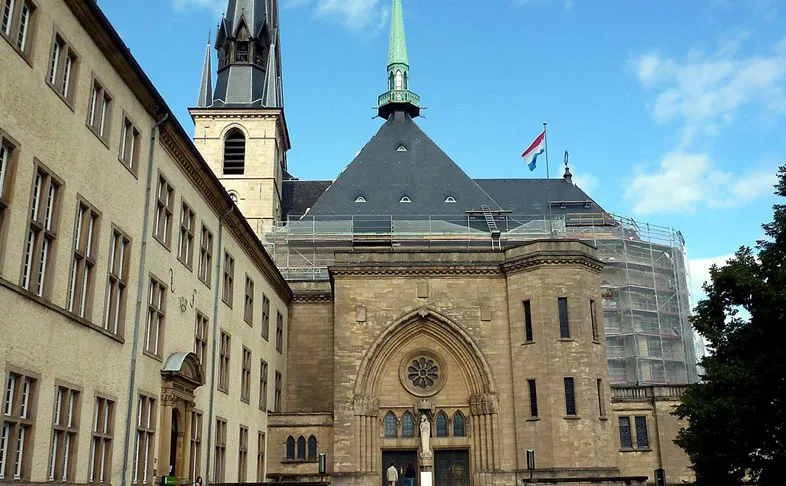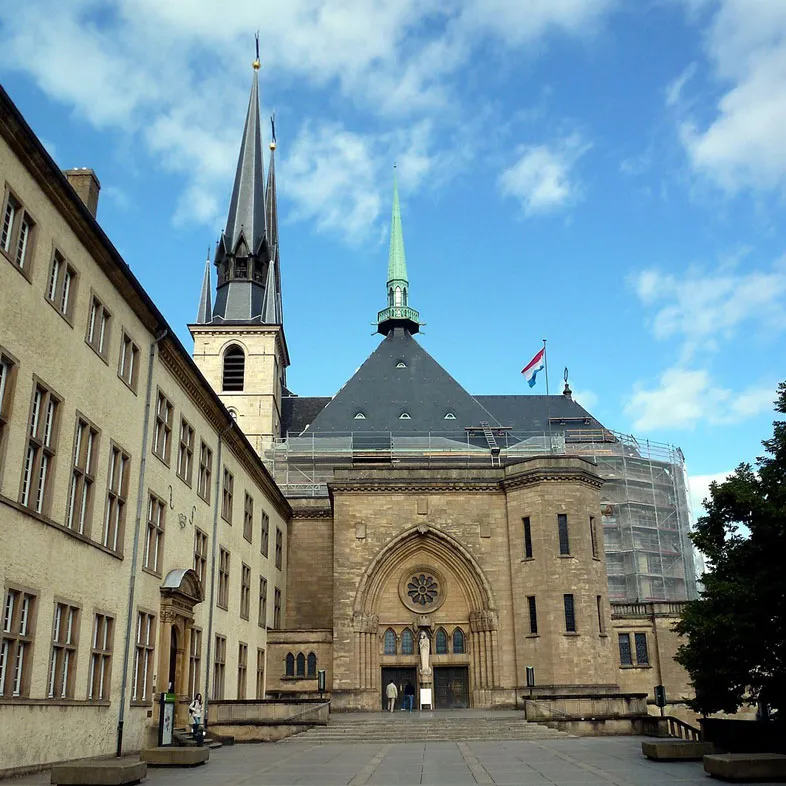
Introduction
Notre-Dame Cathedral, Luxembourg (Luxembourgish: Kathedral Notre-Dame, French: Cathédrale Notre-Dame, German: Kathedrale unserer lieben Frau) is the Roman Catholic Cathedral of Luxembourg City, in southern Luxembourg. It was originally a Jesuit church, and its cornerstone was laid in 1613. It is the only cathedral in Luxembourg.
The church is a noteworthy example of late gothic architecture; however, it also has many Renaissance elements and adornments. At the end of the 18th century, the church received the miraculous image of the Maria Consolatrix Afflictorum, the patron saint of both the city and the nation.
Around 50 years later, the church was consecrated as the Church of Our Lady and in 1870, it was elevated by Pope Pius IX to the Cathedral of Notre-Dame.
At the cemetery of the cathedral is the National Monument to the Resistance and to the Deportation. The centerpiece of the monument is the famous bronze monument by the 20th century Luxembourgish sculptor Lucien Wercollier called The Political Prisoner.
The cathedral was expanded and enlarged from 1935 to 1938.
The former Jesuit church was built beginning in 1613. It of the diocese of Luxembourg in 1870. The Cathedral was enlarged in 1935 by adding a transept, a new choir and a crypt.
History of Notre-Dame Cathedral, Luxembourg
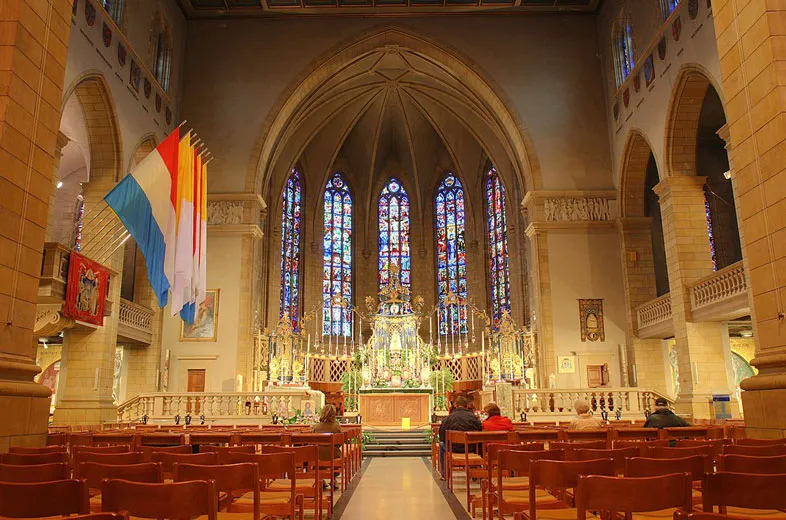
Notre-Dame Cathedral, Luxembourg – Jesuits from Belgium, which like Luxembourg belonged to the Spanish Netherlands at the time, opened a college in Luxembourg city in 1603, where the majority of young Luxembourgers were taught until 1773. The first stone of the church was laid on 7 May 1613, under Father François Aldenard. The constructor of the building was Ulrich Job, from Lucerne. Under him, the decoration of the columns also took place. The Jesuit church was consecrated and dedicated to the Immaculate Conception on 17 October 1621 by auxiliary bishop Georg von Helfenstein.
Artistically, it was above all the German sculptor Daniel Muller (died 1623) from Freiberg (Saxony) who contributed to the appearance of the church, his work including the organ tribune. The decorations in alabaster, a favourite material of Dutch Renaissance sculptors, represent early Baroque angels, who play music between leaves and floral decorations.
After the Jesuits had left the city in 1773, Empress Maria Theresa of Austria gifted the church to the City of Luxembourg in 1778, and it became the new parish church under the name “Saint Nicolas et Sainte Thérèse”. This was convenient, as at the time the old parish church, the church of St. Nicholas on the Krautmaart was small and decrepit, and was demolished in 1779. For this reason, a statue of St. Nicholas stands over the cathedral entrance in Rue Notre-Dame. In 1801 the church was dedicated to Saint Peter.
It received the name “Notre-Dame” on 31 March 1848 under the apostolic vicar Jean-Théodore Laurent. His successor, Nicolas Adames, had the Baroque interior refurbished from 1854 in a neo-Gothic style. When Luxembourg was elevated to a bishopric by Pope Pius IX on 27 June 1870, the Notre-Dame Church became Notre-Dame Cathedral.
Architecture of Notre-Dame Cathedral, Luxembourg
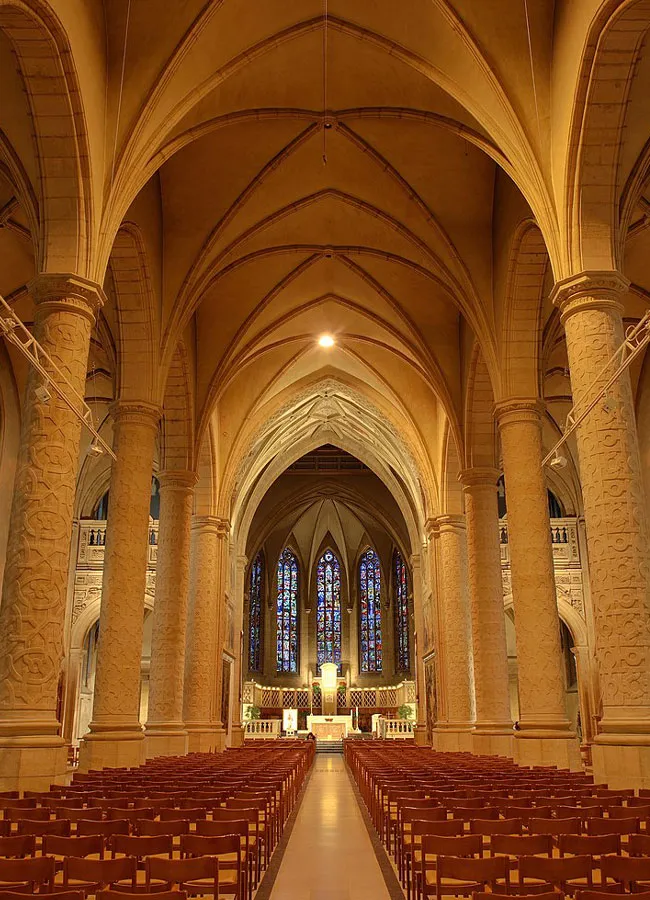
- Architectural style: Gothic architecture
- Architect: Jean du Blocq
Notre-Dame Cathedral, Luxembourg – Though a noteworthy example of late gothic architecture, the cathedral has many Renaissance elements and adornments.
20th century enlargement – From 1935 to 1938 the cathedral was enlarged and expanded. This enlargement, which influenced the silhouette of the fortress city of Luxembourg, went ahead according to plans by and under the supervision of the Luxembourgish architect Hubert Schumacher. The expanded area, which connects to the two choir bays of 1613–1621, characterises the image of the former Jesuit church both due to its spaciousness and through the architectural unity.
The rebuilding of the exterior architecture on the Gothic-style cathedral presented a challenge, since the goal was to harmoniously integrate the church with the surrounding buildings, such as the former Athénée building from the 17th century, the national library, the old church of St. Maximin (1751) (now the Foreign Ministry), as well as the old residential houses.
Towers
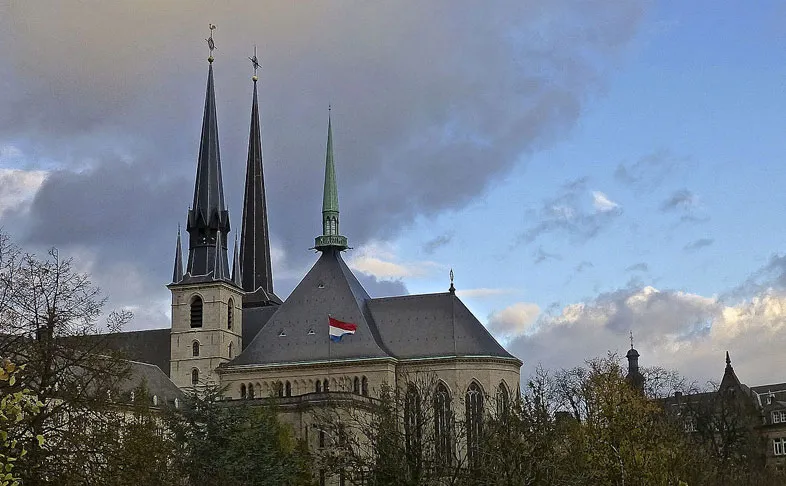
Notre-Dame Cathedral, Luxembourg has three towers: the west tower, which was the tower of the Jesuit church and which contains the bells, the east tower, and the central tower, which stands over the transept.
When the cathedral was enlarged in 1935–1938, the east and central towers were added. The central tower, which is only a third of the height of the other towers, consists of a wide, pyramid-shaped base and a narrow peak covered with copper. The roof itself is carried by a steel frame, consisting of two PN20 beams from ARBED-Belval.
On Good Friday, 5 April 1985, around mid-day, work on the roof caused the west tower to catch fire. The church bells, i.e. the Virgin Mary bell, the Willibrord bell, the Peter bell, and the Cunigunde bell, were destroyed in the fire. When the tower collapsed, the roof of the central aisle was also partly damaged. It took until 17 October 1985 for the tower to be repaired.
Our Lady of Luxembourg

Our Lady of Luxembourg is a devotion to the Blessed Virgin Mary in Luxembourg, called under the Marian title of Comforter of the Afflicted.
A Jesuit Devotion to Promote The Catholic Faith in Luxembourg
The devotion to Our Lady Consolatrix Afflictorum was initiated in Luxembourg by the Jesuits in 1624 and led to the election of Our Lady as the protectress of the City in 1666 and of the Duchy in 1678. After the destruction of the old pilgrimage chapel at the time of the French Revolution, the statue of Our Lady of Luxembourg was moved to the former Saint Peter church, today renamed as Notre-Dame Cathedral in Luxembourg City.
Spreading the Devotion: Our Lady of Kevelaer
From there the devotion was adopted by the English Benedictine nuns of Cambrai as well as in Kevelaer in Germany since 1 June 1642. Following an apparition in that place, an image of Our Lady of Luxembourg was placed there. The devotion spreads not only to the historical provinces of Luxembourg in Lorraine or Belgium but also beyond the oceans as in the United States and even India, helped by the work of Jesuit missionaries.
Becoming a National Emblem of Luxembourg
From the 19th century, as Luxembourg emerged as nation-state, the Consolatrix Afflictorum was more often referred to as Our Lady of Luxembourg, signing an strong association between the Luxembourgish identity and the devotion to Our Lady.
Statue of Our Lady of Luxembourg
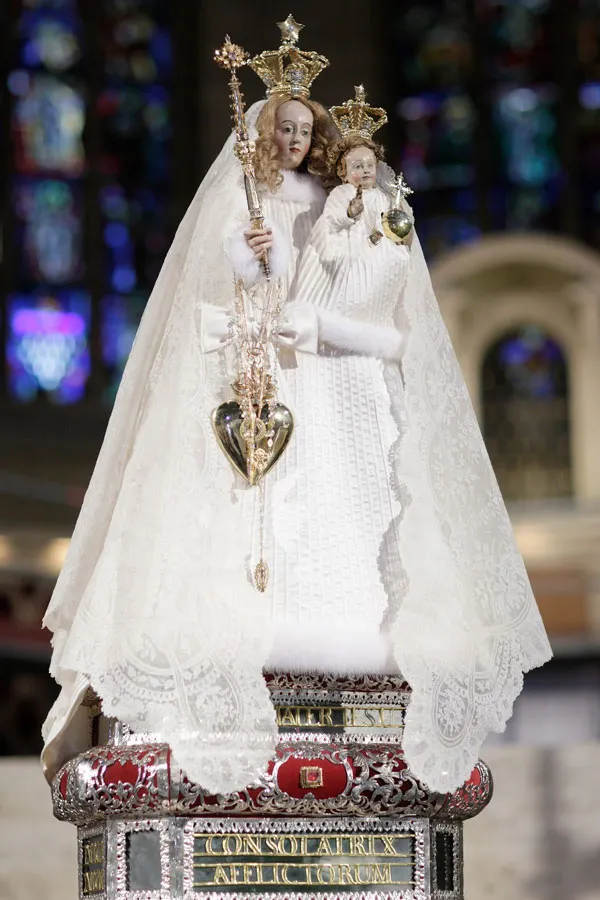
The statue of Our Lady of Luxembourg is currently enshrined in the Cathedral of Our Lady in Luxembourg city.
Statues depicting Our Lady Consolatrix Afflictorum can be found in niches in buildings throughout the city of Luxembourg.
Luxembourgish painter Michel Engels depicted an romantic version of the Consolatrix Afflictorum as the Allegorie de la Patria above the city of Luxembourg, showing that “it is under her watchful and protective eye that the nation achieved its political liberation”.
Takenplatte: fireplace fireback in honor of Our Lady of Luxembourg
As a form of devotion to our Lady of Luxembourg, Takenplatte or firebacks were moulded with her image. They usually depict the Virgin Mary with the Child Jesus, holding a scepter, keys and high crown. Her veil falls down to the ground as a bridal symbol. Above Mary, putti hold a crown of clasps over her crowned head.
It was a very popular plate motif of which several casts have survived. The model has been in use for over 300 years, as dateable casts from 1708 to 1803 have been preserved. Our record is more spartan in nature.
Comparable plates with the identical main motif often have dates, banners and ornamental decorative elements. At first glance, the picture on the Takenplatte bears very little resemblance to the Madonna standing in the Luxembourg Cathedral. This can be explained by the fact that this Madonna was always wrapped in precious clothes for centuries and is also shown on the Takenplatte, among other things. It was only during the last renovation in 2008 that the Madonna’s robes were removed.
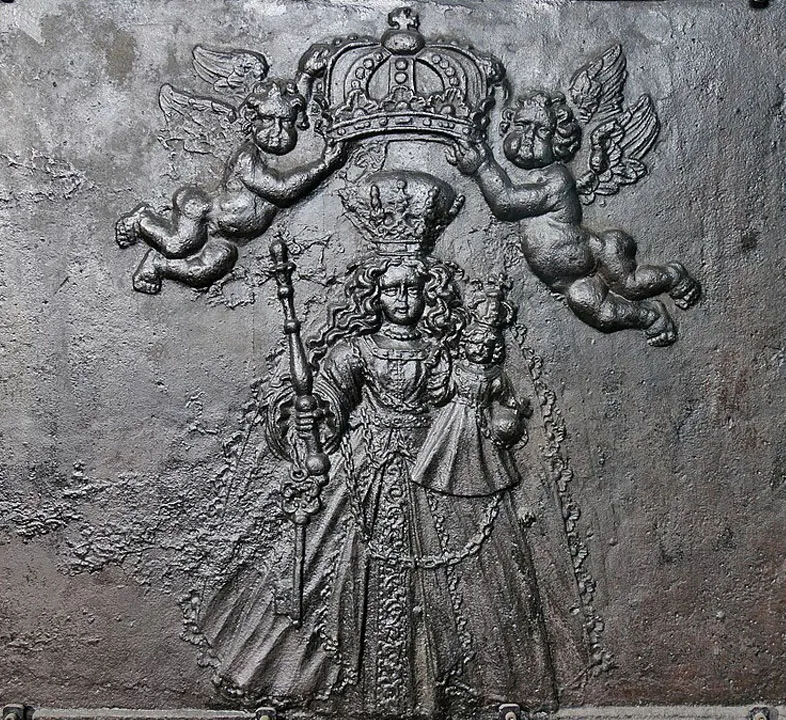
Hymnology
Various hymns have been composed in honour of Our Lady of Luxembourg, the two most popular being O Mamm, léif Mamm do uewen and Léif Mamm, ech weess et net ze son. These two hymns were written in Luxembourgish language. During World War II, they took an even greater significance as their singing was outlawed by the Third Reich which considered them to be too “patriotic”. Well into the 21st century, they remain chosen hymns of the Archdiocese of Luxembourg.
Octave of Our Lady of Luxembourg
The octave celebrations are one of the Grand Duchy’s major annual religious celebrations honouring Our Lady of Luxembourg, Maria Mater Jesu, Consolatrix Afflictorum, Patrona Civitatis et Patriae Luxemburgensis – translated as “Maria, Mother Jesus, Consoler of the Afflicted, Patroness of the City and Country of Luxembourg” if my Latin hasn’t left me. It traditionally starts on the third Sunday after Easter and ends on the fifth Sunday after Easter.
The Octave of Our Lady of Luxembourg is actually a double octave as it celebrated for two weeks.
The Octave of Our Lady of Luxembourg has its roots in a time when plague, famine and war were omnipresent occurrences in Europe and the adoration of images of saints a common way of escaping in the hope of a better future. The marial cult was celebrated throughout the whole of Christian Europe.
Made of lime wood and measuring 73 centimetres, the statue of Our Lady of Luxembourg is known since 1624 when on 8 December, the day of the Feast of the Immaculate Conception, students of the local Jesuit school, today known as Athénée de Luxembourg, carried the Madonna to an open space outside of the fortress of Luxembourg and placed it under a wooden cross. This very first procession had been initiated by the Jesuit priest and teacher Jacques Brocquart.
Due to a high number of donations, the foundation stone for a pilgrimage church was laid at the same place outside of the fortress the following year. During 1626 the whole of Luxembourg including Father Brocquart were struck by the plague. The priest vowed that he would finish the chapel, make a barefoot pilgrimage and donate a candle weighing two pounds if he would make a fully recovery and indeed he soon recovered. In 1628, the Kapell Glacis was consecrated under the vocable of “Our Lady of Consolation” and subsequently became the home of the Madonna.
By 1630 the numbers of pilgrims had reached about 30,000 and two years later the first eight day Marian pilgrimage was held. In 1639, the pilgrimage was celebrated at the Jesuit church for the first time because of the large number of people attending. On the last day, the Madonna was brought back to the pilgrimage church in a grand procession, the origins of today’s closing procession.
Between 1640 and 1642, the Glacis Chapel was enlarged and in the following years the invocation of the Consoler of the Afflicted became increasingly popular among the people of Luxembourg. In 1766, an elaborate votive altar was manufactured on which, to this day, the Madonna is placed during the Octave. During the French revolution the chapel was profaned and later demolished. The Madonna found a new home at the Jesuit church, today known as the Cathédral Notre-Dame de Luxembourg, in 1794.
lready in 1666, the city of Luxembourg had chosen the Virgin Mary as patroness. In 1678, the Duchy of Luxembourg followed by chosing the Mother of God to become its patron saint as well. The celebrations were soon moved from October to the time after Easter. Baroque books of miracles tell numerous stories of answered prayers and faith healings during that time. The pilgrimage was elongated to two weeks in the early 1920’s.
Since the beginning the Octave of Our Lady of Luxembourg had been a national pilgrimage. During the 19th century the devotion to Virgin Mary became an essential part of the national identity for the newly independent Luxembourg. The statue also acted as an important sign of nationality during the German occupation in the Second World War and served as a symbol of consolation and hope for many.
In 2008, the Madonna was restored by Muriel Prieur; it took her no less than 500 hours to bring the statue back in its original shape.
Over the years, the Grand Ducal Family has shown great devotion to the Statue of Our Lady of Luxembourg, Maria Mater Jesu, Consolatrix Afflictorum, Patrona Civitatis et Patriae Luxemburgensis. For example, Grand Duchess Charlotte donated the rosary that accompanied her during her years of exile during World War II to the treasury of the statue. You might also remember that during the recent wedding of Hereditary Grand Duke Guillaume and Hereditary Grand Duchess Stéphanie the family offered various gifts to the treasury of the Lady of Consolation.
While religious festivities are held throughout the whole two weeks, the closing procession is without a doubt the pinnacle of the celebrations. Every year various family members attend the different events though they usually fly under the radar as they take part as normal pilgrims. Holding their rosary firmly in hand, many members of the family always make it a priority to be in Luxembourg for the closing procession. They are joined by Catholics from all over the Grand Duchy of Luxembourg as well as the neighbouring Lorraine, the Belgian Ardennes and the Gaume and Eifel regions.
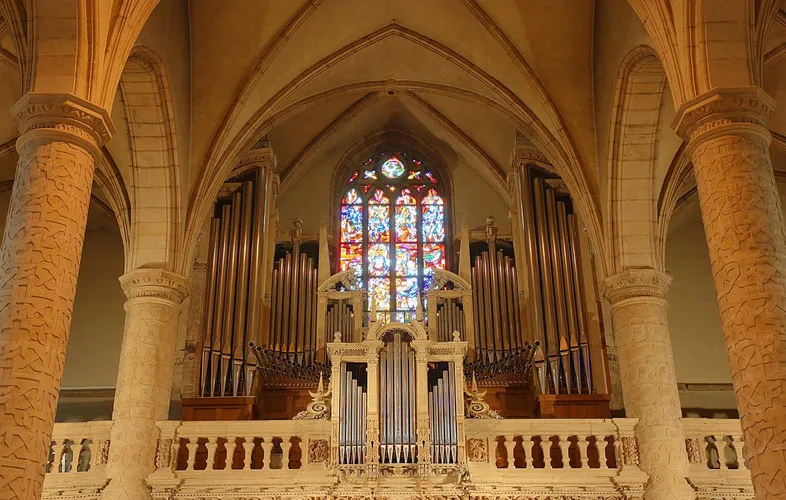
Burials at Notre-Dame Cathedral, Luxembourg
- Prince Charles of Luxembourg (1927–1977)
- Charlotte, Grand Duchess of Luxembourg
- Prince Felix of Bourbon-Parma
- Jean, Grand Duke of Luxembourg
- John of Bohemia
- Princess Joséphine-Charlotte of Belgium
- Léon Lommel
- Marie-Adélaïde, Grand Duchess of Luxembourg
- Infanta Marie Anne of Portugal
- Wilhelm Voigt
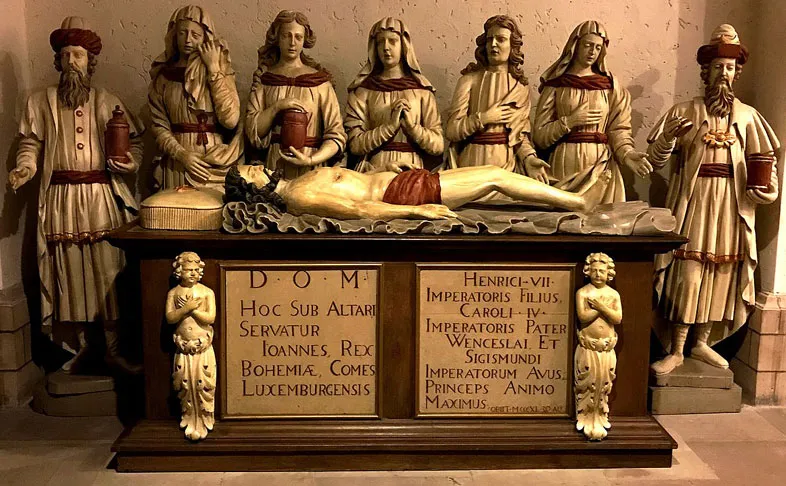
Feast Day
Annual Feast Day of Our Lady of Luxembourg is held on 15th September Friday before Good Friday.
Mass Time
Saturdays
Sundays
Church Visiting Time
Contact Info
Rue Notre Dame, 2240, Luxembourg.
Phone No.
Tel : +352 22 29 70 1
Accommodations
How to reach the Cathedral
Luxembourg Airport in Luxembourg is the nearby airport to the Cathedral.
Luxembourg, Place de Metz Tram stop in Luxembourg City, Luxembourg is the nearby Tram Stop to the Cathedral.

